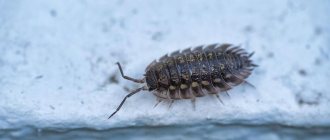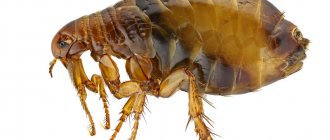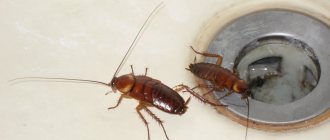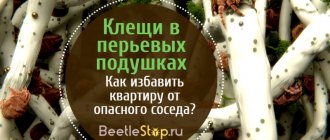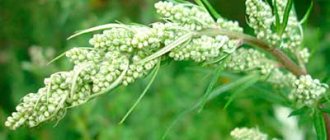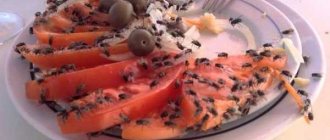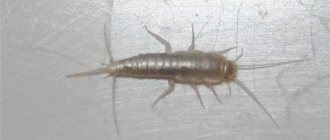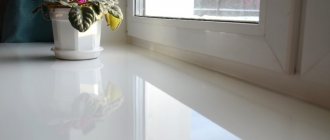Linen lice are a subspecies of human lice. They were identified as a separate group due to the peculiarities of their existence - unlike head parasites, these insects do not live on areas of the human body covered with hair, but on clothing. In addition, during the period of their evolution, they were able to adapt to life on clothing as much as possible, so existence on the human body became almost impossible for them. Let's get to know these parasites better so that we can be fully prepared when they appear.
Like head louse, linen louse is dependent on environmental conditions and the lifestyle of its owner. And having become familiar with the peculiarities of its existence, you can rid your home of these parasites in the shortest possible time without the use of poisonous drugs.
What do linen (body) lice look like?
The appearance is not much different from other types of lice. These are insects 3 – 3.5 mm long, some individuals reach 5 mm. They have a flattened, elongated body of a light brown color. When saturated with blood, they darken and increase in size. The parasite has three pairs of legs, their shape and structure are slightly different from the legs of head or pubic lice. During its development, the body louse has adapted to move mostly not along hairs, but along clothes, linen and skin. Because of this, the legs of body lice are less tenacious than those of other species.
The mouthparts are equipped with sharp stilettos, which they use to pierce the skin. The blood is sucked out using the proboscis. They are also injected with a substance that prevents the blood from clotting. Because of this location, linen lice bites most often result in bruising.
The eggs of linen lice are the same as those of head lice. They are round, white, 1 - 1.5 mm in size. Usually females lay them in a heap, in one place. The clutch can be noticed precisely because of the large number, since the nits themselves are very small.
Causes of appearance and routes of infection
Bed lice are transmitted through household contact directly with a carrier of body lice. It is impossible to become infected with it from domestic or wild animals.
A linen louse can crawl only short distances in search of a food source. The speed of movement of the insect is 20 cm in 1 minute. Therefore, transmission is possible through bedding, while trying on things, as well as when wearing someone else's clothes.
One of the ways of infection
Potential places where linen lice come from:
- hostels;
- sanatoriums;
- trains;
- swimming pools;
- saunas;
- second-hand shops;
- summer camps;
- prisons;
- public transport;
- hotels;
- schools;
- kindergartens.
Life cycle
This parasite goes through several stages in its development:
- nit – an egg in which a larva develops; development occurs within 5–8 days;
- nymph of the first, second and third order - the larva emerges from the egg and goes through three molts, increasing in size; this stage usually takes from 16 to 21 days;
- imago - an adult individual.
Body lice begin to bite and drink blood already at the nymph stage, but only adult insects can mate and reproduce. The female lays an average of 4 eggs per day. Over the course of its life, it lays more than a hundred nits, so lice must be dealt with immediately after detection in order to prevent a sharp increase in the population. There are also particularly fertile individuals that can lay up to 300 eggs in their lifetime.
Folk remedies
There are also some folk methods for removing lice that are worth mentioning here:
Dust soap
A wonderful pediculicide, actively used by people. First, the soap is grated. The resulting shavings are dissolved in water and beaten. To completely remove lice, one treatment is sufficient. Remember that you need to carry out the processing procedure while wearing rubber gloves. Contact of dust soap with the skin is extremely undesirable. After the procedure, the laundry should be rinsed thoroughly. Do not neglect safety tips, as dust soap is a toxic substance.
Tar soap
This drug should be used like dust soap. Unlike the latter, tar soap does not pose a danger to human health. But the effectiveness of this remedy is much less.
Some herbs are also used against body lice, but it must be said that they are even less effective than tar soap, and they are used more as a prophylactic agent or for low degrees of infection.
You can wash infected laundry in mint decoction; the smell is simply disgusting to lice, but this remedy, of course, cannot be called effective. Lemon juice is also used to remove parasites; it is added in large quantities to the water in which contaminated laundry is washed. Also for this purpose, use an alcoholic infusion of angelica or a mint decoction.
Living conditions
A louse lives 30–40 days. To live and reproduce, it needs to have access to a food source. The parasite feeds up to 6 times a day.
The decisive factor determining life expectancy is air temperature. The most comfortable temperature is 31 degrees. It is under these conditions that all types of lice live and reproduce. When it drops to 20 degrees, the louse stops reproducing; when it gets colder, it goes into suspended animation and dies after a couple of days. High temperatures of more than 40 degrees are also detrimental to the parasite.
Lice can survive in high humidity. They are not even afraid of water and can stay in it without risking their lives for some time. Drought is more destructive for them.
Symptoms of the appearance of bloodsuckers
It is impossible to detect parasites in bed or underwear when their numbers are small, since they hide in secluded places. Only in the process of their life activity and active reproduction do characteristic signs appear that indicate the presence of bloodsuckers.
Among them:
- annoying skin itching;
- rash at bite sites;
- scratching.
As unpleasant symptoms increase, the person becomes irritable and has trouble sleeping. Adults are more susceptible to body lice; in rare cases, it is diagnosed in children.
Lifestyle
Linen lice spend most of their lives outside the human body. They lay eggs in linens and clothes. They're hiding there. Where can you find body lice:
- bed linen and accessories - pillows, blankets;
- mattresses;
- cushioned furniture;
- towels;
- clothing, including on a person or folded in a closet;
- carpets, curtains and other home textiles.
Any soft things that retain heat can become a haven for insects. They can be found on the back walls of cabinet furniture, paintings, and under wallpaper. They do not penetrate deeply into upholstered furniture, like bedbugs, but they are quite comfortable under the upholstery.
Bed lice live in clothing and other textiles, but they need food to live. The source of food is man. Lice must be near a person to access their blood several times a day. This insect can go without food for up to two days, but under normal conditions it feeds every 4 hours.
Linen lice do not jump or fly, but they can move very quickly across surfaces. In half an hour, the insect will cover a distance of up to 50 cm. They try not to live at a greater distance from a person. That is why they usually live in bed, because there the access to human blood is most convenient and quick.
Complex events
To completely get rid of parasites and prevent re-infestation, it is necessary to carry out a whole range of measures that will help destroy body lice. If they managed to reproduce, then some individuals probably ended up not only on clothes, but also on the bed, bedding, and personal belongings. Also, nits and parasites can be found on floors, curtains, carpets, so you cannot do without treating the entire apartment.
How dangerous are bed lice?
Like all other blood-sucking parasites, linen lice can be carriers of diseases. They can live on more than one person, which means that when they bite, they carry pathogens on their mouthparts. When they bite, they inject these blood particles and thus spread infections. It is linen lice that spread typhoid fever, relapsing fever and other infectious diseases.
In addition, the bites of linen lice themselves pose a health hazard. As already mentioned, when they bite, so that the blood does not clot immediately, they inject special active substances under the skin that can cause severe allergic reactions.
In addition, lice bites are irritating and cause unbearable itching. A person constantly scratches the affected areas, which do not heal for a long time and can become re-infected. This leads to dermatitis, skin and infectious diseases, fever and even blood poisoning.
When infested with linen lice, pediculosis is diagnosed. This is a disease that needs to be fought. It doesn't go away on its own.
What harm can they cause?
The disease caused by lice is called pediculosis. Its symptoms are varied and depend on the number of bites and the characteristics of the body.
Redness and itching
The first and obvious symptoms are redness and swelling of the bite site. Papules are very itchy, scratching does not bring relief, the spots become brighter and more inflamed.
See also
How to properly steam a wedding dress at home
Allergy
During bites, lice saliva enters the wounds and provokes allergic reactions. Allergies are manifested by increased itching, the appearance of skin rashes, nausea, and digestive disorders. In severe cases, the temperature may rise.
Information: body lice carry typhus, relapsing fever, and Volyn fever, which makes infection with pediculosis especially dangerous.
Ulcers
Ulcers appear at the site of scratching, the skin often becomes rough, takes on an unnatural appearance, and thickens.
Pyoderma
When scratching, infection with pyogenic bacteria often occurs and pyoderma develops.
General malaise
General malaise is the result of numerous bites, allergic reactions, and insomnia.
Irritability
Constant itching causes nervous system disorders and poor sleep. Fatigue accumulates and irritability appears.
Infection through scratching
If pathogenic microorganisms enter through wounds, infectious infections occur, in particular furunculosis.
How to get rid of linen lice
When bed lice are detected, comprehensive control is necessary. You need to get rid of insects and nits that can be on the human body and on his things. If parasites are found in one of the family members, not only him, but all of them will have to be treated.
Firstly
It is necessary to destroy insects on clothes. To do this, it must be washed at temperatures above 40 degrees. To be on the safe side, you can pre-soak things in a pediculicide solution. After washing, you need to dry the clothes well, you can do it in the scorching sun or, conversely, in the cold. Then you should iron your clothes and linen on both sides with an iron. It is good to use a steam generator for processing.
If items cannot be washed in the usual way, they can be dry cleaned. If they are not subject to any processing at all, you need to put them in a sealed plastic bag and leave them there for 2 or 3 weeks. During this time, the parasites will die due to lack of food. Eggs laid during this time will not be able to develop and will die. After such imprisonment, the item must be thoroughly cleaned to remove insects, nits and traces of their presence.
You can also use the temperature method. For example, pillows, blankets, rugs can be taken out into the scorching sun or bitter cold. This is a folk method that does not lose its relevance. But things must be subjected to heat treatment for several hours.
Secondly
All furniture needs to be treated. For cleaning, you should use a steam generator or call special services that use professional cleaning products. Steam treatment is effective because it penetrates the entire thickness of the furniture and destroys insects that are deep under the upholstery.
Any home textiles and cabinet furniture should be treated with pediculicides. We recommend using preparations for the destruction of lice produced by MediLIS Laboratory LLC. All of them are effective against insects and nits, for the destruction of which one treatment is enough. There are preparations that can even be used to treat children over 5 years of age and their belongings.
Also, with insecticide solutions, you need to wash all floors and any surfaces in the room on which adult lice or eggs may remain.
Third
It is necessary to process all people living in this room.
Despite the fact that body lice do not live on the human body, they can hide in hair, and nits can be found under skin flakes. On a person, a linen louse can survive difficult times, after which it will move to more comfortable conditions, where it will continue to live and reproduce. To ensure that you get rid of lice, you need to thoroughly wash your body and hair with pediculicidal products. To be on the safe side, comb your hair with a fine-toothed comb. That is, carry out the same treatment that is carried out when fighting head lice. Considering that the incubation period for nits is 5–8 days, after a couple of weeks it is worth carefully inspecting the room, clothes and underwear to detect new individuals. Due to the small size of the eggs and their ability to survive difficult times in a state of suspended animation, it may turn out that even complex treatment does not destroy absolutely all nits. Therefore, additional checking and processing will not hurt.
Chemicals
Getting rid of linen lice is not difficult. However, this requires certain knowledge and compliance with certain requirements. To get rid of parasites, it is best to adhere to comprehensive measures. You should start with hygiene procedures. At the pharmacy you can purchase many effective drugs in the form of shampoo, spray or emulsion. Antiparasitic agents include permethrin, dimethicone, benzyl benzoate or butadione.
After applying the treatment, the lice lose mobility and die. However, the procedure for treating the surface of the body should be repeated several more times: nits often easily tolerate chemical exposure. Among the most effective drugs for linen lice are NOC, Pedilin, Permethrin, Mediforks, Nix. Before using the drugs, you must carefully read the instructions. After all, many of them have serious contraindications. Allergy sufferers, pregnant and lactating women, and when applying the product to small children should be especially careful.
After treatment with medications, a burning sensation may occur. Ointments “Zvezdochka”, “Rescuer” or other antibacterial agents will help get rid of it and speed up the healing of wounds. If allergic reactions to lice bites occur, you should start taking antihistamines.
Anti-linen lice medications can cause an allergic reaction. Young children, pregnant women and people with allergies should be especially careful.
In parallel with procedures related to disinfection of the body, clothing should be treated. To do this, use a washing machine. Set the wash cycle to the highest temperature. Before putting things into the drum, soap them with tar soap. Add 2-3 tbsp to the powder compartment. l. acetic acid. This way you will get rid of not only adults, but also nits (acid corrodes the chitinous shell on insect eggs).
Prevention
Bed lice are more difficult to catch than head lice. To do this, you need to come into contact with the personal belongings of the sick person. These parasites have become widespread among people with low social responsibility. Failure to maintain personal hygiene and cleanliness of personal items leads to the development of insect populations. If you don't fight them, their number increases exponentially.
Most often, linen lice are found in people without a fixed place of residence who do not have the opportunity to wash themselves and wash their clothes. Also, body lice can occur in places with a large concentration of people without constant access to sanitary facilities. These are prisons, hospitals, long-distance trains. Oddly enough, these parasites are also found in children's educational institutions.
If there is a suspicion of infestation with linen lice, preventive measures must be taken immediately. Wash clothes and linens at 40 degrees or more, iron them or treat them with a steam generator, treat furniture and other surfaces with insecticides, wash your body and hair with special anti-insect preparations. It is better to take unnecessary precautions than to allow the development of head lice, which will then have to be treated for a long time.
Where do parasites come from?
The myth that lice only appear in marginalized families is misleading. Any person who lives in a clean and orderly manner, communicates with people of different social statuses and is outside the home during physical contact with infected people can become infected:
- in crowded places - buses, trains, markets;
- in public places - public baths, fitting rooms in shops, hospitals, hotels
- in other conditions - at a party, in camps, in educational institutions.
The favorite place for bed lice is the bed, as this is the easiest place to reach the victim.
Note! Mattresses, pillows, bed linen are their main home. They live directly in the folds of tissue, where eggs are laid.
Lice can also migrate to clothes in contact with the body: underwear, blouses, and move into the closet, into modest corners of the shelves. Particular attention should be paid to the basket in the bathroom with dirty laundry, where dirt accumulates and creates comfortable conditions for the proliferation of parasites.
Preventive measures
By following simple preventive measures, you can prevent the risk of contracting body lice.
Basic recommendations:
- If you are staying in a room with unsanitary conditions, you must use essential oils that repel parasites.
- Regularly dry clean rugs, blankets, and pillows.
- After washing, be sure to iron things.
- Carpets and upholstered furniture should be vacuumed in a timely manner.
- You can't wear other people's things.
- You should adhere to the rules of personal hygiene.
- If you purchase clothing from a second-hand store, you should wash it at a high temperature before wearing it.
- Maintain social distance on public transport.
